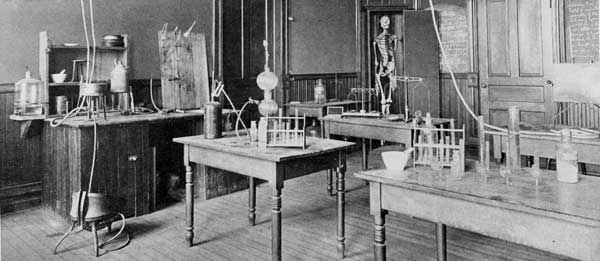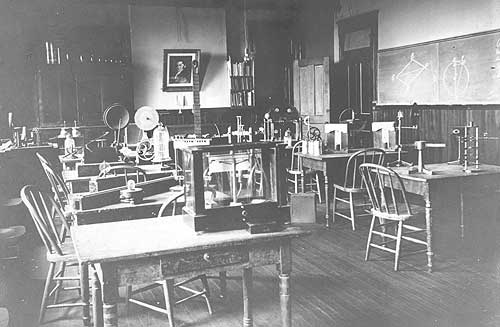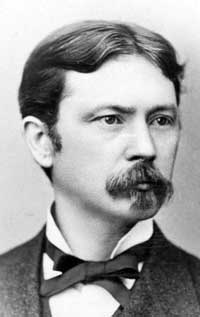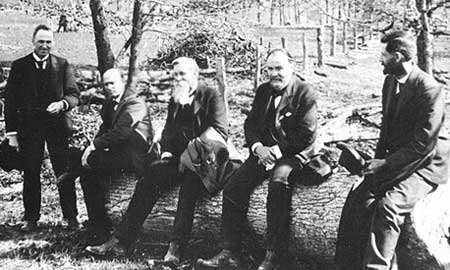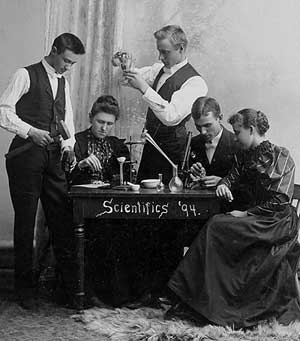Quest for scholarship included science early on
(This story was written in celebration of Augustana's sesquicentennial in 2010.)
"Geology at Augustana can be viewed as an expression of the desire for openness and inclusiveness, the willingness to follow wherever legitimate scholarship might lead, characteristics of those branches of the Lutheran church that have owned, and supported, the college from its very beginning."
So wrote Augustana geology professor Richard Anderson ('52) in a 1992 memorial volume to Fritiof M. Fryxell ('22), who was perhaps the best-known and most influential science professor in the history of the college.
But the tradition to which Anderson refers in this passage — a tradition in which the sciences are an element of, rather than antithetical to, a Lutheran education — goes back much further than the start of Fryxell's career as an Augustana faculty member in the 1920s.
The beginnings of science at Augustana
As Fryxell reports in his brief history, "Science at Augustana College" (1922), Augustana's first president, Reverend Lars Paul Esbjörn, was himself a scientist of sorts. Before assuming the presidency of the new Augustana Seminary in 1860, Esbjörn taught science and mathematics at Illinois State University, and he took a personal interest in astronomy, physics, chemistry, and math throughout his life.
Both Fryxell, in "Science at Augustana," and former Augustana president Conrad Bergendoff, in his article, Fritiof Fryxell and Augustana, attribute to Esbjörn an early recognition that the new seminary must ultimately prepare students for a variety of careers by teaching a variety of subjects, including science.
The early Augustana curriculum, however, focused primarily on languages and religion. It was not until 1876 that an Augustana professor, Reverend Henry Reck, began teaching a course in Natural Philosophy, which involved much recitation and no hands-on laboratory work. In the late 1870s, Reverend A. R. Cervin offered an optional field course in botany.
Josua Lindahl
The sciences became a permanent part of the Augustana curriculum with the appointment in 1878 of Johan Harold Josua Lindahl as professor of natural science and mathematics. Lindahl was Augustana's first full-time professor of science and its first professor who was not also a minister. His charge was to establish a Natural Science Department at the college.
Lindahl earned his doctorate in 1874 at the University of Lund in his native Sweden. In the early- to mid-1870s he made a name for himself internationally: Among other accomplishments, he participated in deep sea expeditions, served in prestigious European museums, and acted as curator for Sweden's exhibits at the 1876 World's Fair in Philadelphia.
At Augustana Lindahl found relatively inferior conditions. The science facilities were located in what was then known as "House Number Two," which would later become the president's home; there was little in the way of laboratory equipment or "modern" scientific amenities.
Yet Lindahl arrived at just the right time. As Bergendoff reports in his college history, "A Profession of Faith" (1969), Augustana's increased emphasis on science in the 1870s coincided with that of many schools in the United States.
Moreover, the Augustana Synod explicitly supported this emphasis: According to Bergendoff, the synod in 1876 (two years before Lindahl was hired) determined that science classes should be offered at Augustana through the college level, rather than being limited to the preparatory level, which had apparently been suggested by the faculty. In other words, the church body itself was responsible for advocating science instruction.
Under Lindahl's direction, the college's science offerings immediately expanded: Lindahl taught zoology, botany, physiology, and chemistry in his first school year. The Natural Philosophy course, originally taught by Henry Reck, soon became a physics class.
Lindahl also quickly developed a reputation as an excellent teacher who knew how to motivate students. An avid museum enthusiast, Lindahl actively developed Augustana's natural history museum, which he believed would spark interest in students who might not otherwise recognize the importance of science.
Put together, Augustana's administrative decisions, Lindahl's personal contributions, and the prestige his famous name brought to Augustana ensured that the college's fledgling science program had a solid foundation. When Lindahl left the college in 1888 to become Illinois State Geologist, he was replaced by a former student: J. A. Udden.
J. A. Udden
Johan August Udden was born in Sweden in 1859; his parents immigrated to Minnesota in 1861. He earned his bachelor's in 1881 and his master's in 1889, both from Augustana. When Augustana hired Udden in 1888, he was serving on the faculty at Bethany College in Kansas, where he had been a founder and one of the first instructors.
But Udden returned happily to Augustana. After Lindahl's departure, responsibility for the science program was divided, effectively doubling the size of the full-time science faculty. Udden served as professor of biology and geology, while first Jacob Westlund and then Victor O. Peterson served as professor of physics and chemistry.
Yet it was Udden who had the greatest influence on the progress and reputation of Augustana's science program at the end of the nineteenth and beginning of the twentieth centuries.
Like Lindahl, Udden was known as an excellent teacher; his dedication to student learning was such that, in the late 1890s, he spent $100 of his own money (more than $2,500 today) on a dozen microscopes and other scientific equipment for use by Augustana students in their classes.
Udden also developed a national reputation as a geologist during and after his 1888-1911 tenure at Augustana, a reputation that, like Lindahl's, brought prestige to the college. While at Augustana, Udden conducted the research that led to his presentation of a grain-size scale for wind deposits in The Mechanical Composition of Wind Deposits (1898), the first in what became a long series of Augustana Library publications.
Udden's grain-size scale classified particles on the basis of their measurable size. For example, he defined "coarse gravel" as being 4-8 mm in diameter, "gravel" as 2-4 mm, "fine gravel" as 1-2 mm, and so on, using a consistent ratio: the diameter of particles in each category was half that of those in the next larger category.
More than 20 years later, University of Iowa geologist C. K. Wentworth, in A Scale of Grade and Class Terms for Clastic Sediments (Journal of Geology, 1922), proposed a more thorough scale that included aqueous and glacial deposits as well as wind deposits. Wentworth used Udden's grain-size scale as the basis for his own scale, noting that Udden's classification scheme was the only one he could find that employed "the uniformity of ratio of the geometrical series which seems to the writer to be essential to any thorough quantitative study of the mechanical composition of sediments."
Wentworth's 1922 scale is known and employed by geologists to this day as the Udden-Wentworth grain-size scale.
Udden's other most noteworthy accomplishment came after his tenure at Augustana, while he was a geologist at the Bureau of Economic Geology and Technology at the University of Texas. There, Udden's recognition that drill cuttings could be analyzed to determine the presence of oil, gas, and water in subsurface sediments led to the discovery of oil in the West Texas basin.
But even Udden's later accomplishments reflected well on Augustana, where he had earned both his degrees and launched his research career. Augustana granted him an honorary Doctor of Philosophy in 1900 and an honorary Doctor of Laws in 1929.
Changes to the curriculum
In addition to his contributions as a teacher and researcher, Udden was one among a handful of faculty who encouraged curricular changes at Augustana that placed greater emphasis on the study of science.
In "A Profession of Faith" Bergendoff recounts the college's 1895 adoption of two parallel but overlapping "courses of study": a classical course and a scientific course. In other words, science was singled out as an area of focus, similar to a "major" today.
The new scientific course required less Latin than the new classical course, and no Greek at all, focusing more on French and German instead, as well as natural history, geology, chemistry, physics, mathematics, and astronomy. The classical course still required some science, though less than the scientific course. And both courses required what Bergendoff calls a "common core" of classes in Swedish, Christianity, history, and philosophy.
Both Bergendoff, in "A Profession of Faith," and former Augustana President Thomas Tredway, in "Coming of Age: A History of Augustana College, 1935-1975," attribute to then-President Olof Olsson the recognition that such changes were beneficial, and even necessary, to a college and theological seminary seeking to make its way in late 19th-century America. Olsson understood that Augustana must focus on quality education, promote scientific study, and teach Christianity at a "high academic level" in order to succeed.
Part of what led to the college's greater emphasis on science was the effort made by faculty members such as Udden, faculty who were in touch with developments in education across the country.
Science in the 20th century and beyond
In the long run, Augustana's increasingly greater emphasis on science was not just economically practical. Rather, science at Augustana has been, in many ways, an expression of just the perspective articulated by Richard Anderson in the quote that opens this story: i.e., a perspective of support and encouragement of inquiry, which Anderson associates with the Lutheran church itself.
Perhaps this perspective explains why, in "Fritiof Fryxell and Augustana," Bergendoff can report on the relatively minimal fuss occasioned even by biology professors' teaching Darwin's theory of natural selection — and this in the early 1920s, before the Scopes "Monkey" Trial.
As Tredway writes in "Coming of Age," Bergendoff himself believed that "faith...enlightened reason, gave its discoveries their ultimate meaning"; therefore, "the final meaning and place of (the sciences') work in the universe of learning was determined by the larger view of life which Christian faith afforded." This perspective was reflected in Bergendoff's 1935-62 presidency.
Today, the college boasts numerous excellent science programs — some of which are nationally respected — even as it maintains its ELCA affiliation and promotes discussion of religion and religious faith. That peaceful coexistence of science, religion, and religious study is not merely a 20th-21st-century phenomenon but, rather, the legacy of 150 years of science at Augustana.
— Stefanie Bluemle ‘02
Reference Librarian

